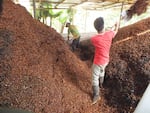From fancy machines to the humble pour-over, coffee comes in many forms. If you haven't tried at least one method today, you're in the national minority: Market research shows more than 60% of Americans drink coffee every single day.
This widespread obsession demands just one part of the coffee plant: the seed. More often than not, the edible fruit surrounding that seed is thrown away, becoming a colossal source of food waste in coffee-producing countries around the world.

Riff's taproom in Bend, Ore., specializes in cold-brewed coffee products.
Emily Cureton / OPB
But at Riff’s Bend cafe, there’s a new drink on the menu. It’s cold and fizzy, the color of honey poured over ice. The can reads "Alter Ego, natural energy, cold brewed from the fruit of the coffee plant."
“It tastes nothing like coffee,” explains Paul Evers, a co-founder of Riff. He's hoping to reduce the waste that results from normal coffee production and profit from more consumer awareness about coffee's environmental impact.
“This has incredible nutritional value. It's delicious. It's wonderfully complex. It's naturally caffeinated … and we're throwing it away,” Evers said while sipping this drink made from what much of the coffee-producing world treats as an afterthought.
He said some people taste dried cherries or apricots when they try "Alter Ego." This reporter struggled for something to compare the flavor to, settling for her childhood happy-place of perfectly watered-down Dr. Pepper with crushed ice.

Riff co-founder Paul Evers sits at a table of dried coffee fruit products at the company's Bend, Ore., taproom on Jan. 10, 2020.
Emily Cureton / OPB
How coffee fruit compares to other beverages is just one of the marketing conundrums new sellers face, from small outfits such as Riff to industry giants like Starbucks. In many ways, good intentions drive the trend, but there are unanswered questions.
Chief among them: How beneficial for the environment is this, really?
Riff’s claims attracted interest from University of Oregon’s sustainable business program, where this semester students are analyzing Alter Ego as a case study in how to accurately define and measure sustainability.
Related: How A Portland Nonprofit Brings Better Coffee To Your Cup
Evers hopes sharing proprietary information with the business students will help Riff refine its pitch to consumers, and encourage other small-batch beverage makers to utilize a staggering supply without much demand. He has a background in the Pacific Northwest’s craft beer industry and sees parallels.
“What they were doing is getting consumers to migrate from mass-produced beer over to locally-produced beer ... I think that's a really great model for us to refer to in forming a coffee fruit trade organization,” Evers said.
About 15 years ago, El Salvadoran farm owner Aida Batlle started her own experiments to make coffee fruit appealing as a specialty food trend. Now, she sells it all over the world, calling it by the Spanish word for peel, "cascara."
“It's definitely helped us, because it's a product that used to either compost … or you threw most of it away,” Batlle said.
Her buyers are making drinks, baked goods and even beer. Meanwhile, the commodity price of coffee beans has plummeted, hovering around a five-year low.

Workers on a Peruvian coffee farm shovel coffee fruit in this file photo from June 2013.
Courtesy of Martin Fritsch / Sofies
“Some people can’t afford to actually work the farms because right now at these prices, you don't even break even,” Batlle said, adding that she does OK because her coffee beans fetch specialty prices. But, she can’t avoid the effects of climate change, screwy rain patterns and increasingly stubborn outbreaks of a plant disease called coffee leaf rust. That’s why Batlle welcomes an additional source of income on each crop, even though cascara costs money to process safely.
“Producers have to be careful because it's not as easy as taking a bunch of pulp, and then just throwing it on a patio or a drying bed,” Batlle said.
The wet fruit is susceptible to mold and other contaminants, while health and safety standards fall in a regulatory gray area in the United States. For now, it’s up to producers and buyers to set and enforce their own standards.
Bend-based coffee company Riff is marketing its coffee fruit drink as clean energy in a can, ethically sourced and sustainable. University of Oregon instructor Josh Skov said it’s a good case study for the sustainable business program because the company is “mission-aligned.”
“I'm always trying to help companies that are genuinely interested in understanding their impacts, and improving them,” Skov said. “As a company, before you go off and start making claims, you kind of want to know 'Are these results plus or minus 5% or plus or minus 50%?'”
Through Skov's lifecycle-analysis class this semester, Riff will get help figuring out how to market its product. The students get valuable experience in return.
“Part of my role really is to help my students get to a different level of critical thinking so they aren't accidental greenwashers in their future jobs,” Skov said.

Riff's taproom in Bend, Ore., sells caffeinated "Alter Ego" banana bread, made from coffee fruit flour seen on Jan. 10, 2020.
Emily Cureton / OPB
Greenwashing means falsely making consumers believe a product is environmentally friendly. To gauge whether one product is truly better or worse for the environment than another, or to even brand something as green, you need a basis of comparison. That’s tricky with a flavor still so foreign in the United States.
One place where consumers are familiar with coffee fruit is the Arabian Peninsula. Abdulrahman Al-eryani is a development professional from Yemen, who traces qishr — a traditional brew of spiced coffee fruit — back from the 1500s to his own daily life.
“Since growing up, the pot of qishr is there. It is in our living room, from morning until late afternoon …," he said. "It's neither a coffee or tea. It's literally a third space by itself, by its own."
After years of civil war, commodity prices are so high that now many Yemeni consumers can’t afford domestically-produced coffee fruit, which Al-eryani described as an agent of social cohesion in one of the world’s first coffee-growing regions.
“It brings people together ... for any social gathering qishr is a fundamental ingredient.”
In Oregon, that same ingredient is being packaged very differently and sold with an appeal to consumers: enjoy the whole coffee plant, and explore where it comes from.
